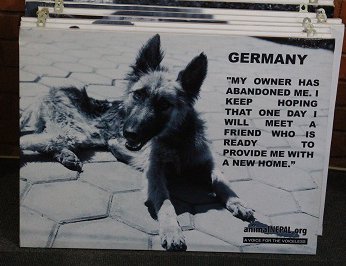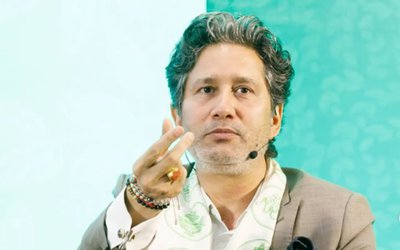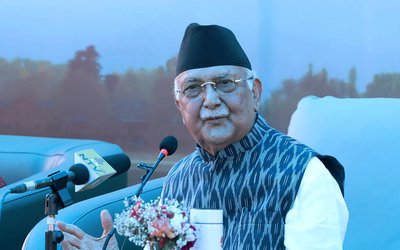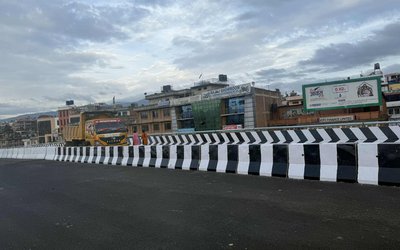
Walking along a street in Kathmandu, one encounters the bewildering juxtaposition of religious altars and a slew of haggard, emaciated dogs that will make any theologian ponder the role of God as a passive observer, indifferent to suffering and pain.; and perhaps, this anthropomorphic idea of God is paralleled by the attitude of most people here when scores of starving or abused animals are unveiled before their eyes as they walk the streets of the Kathmandu valley.
Lucia, who runs Animal Nepal together with a dedicated team of educators, veterinarians and volunteers, attributes this startling phenomenon of indifference and apathy to one feeling “overwhelmed” by the sheer amount of suffering they are confronted with on a daily basis; pretty much so that they become desensitized to suffering altogether.
Exuding immeasurable charm and passion, Lucia De Vries hails from the Netherlands and has lived in Nepal for twenty years. After a brief stint as a Journalist, she decided to found Animal Nepal and in 2003, she and a “group of friends” established a non-governmental organization that would, for many years to come, provide a safe sanctuary for injured stray dogs and severely abused donkeys; and the latter’s mistreatment Suraj, a campaigner at Animal Nepal, describes in visceral detail conveys a reality that is an once frightening and horrifying.
Collectively cramped into a truck, the donkeys are transported on a 12 hour treacherous journey from Nepalgunj, where they are randomly picked off the streets, into Kathmandu; by the time the journey ends, some are found dead and most are left with broken legs. In a country where the Animal Welfare Act has yet to be implemented, donkeys are used in most brick factories to carry humongous loads of bricks and they stray from their designated path- as animals naturally do- they are brutally beaten or whipped into soul-crushing submission. Of all the images that Suraj’s descriptions conjure up, the most disturbing one is that of a donkey, whose skin had been sloughed off due to overburdened loads. And though Animal Nepal makes it a point to visit every brick factory in Lalitpur, where the non -profit organization mainly operates, and inspect the conditions of the donkeys as well astalk the donkey handlers into lessening the brick load, Suraj admits that the country still has a long way to go in terms of donkey emancipation.
Regarded as dumb animals, donkeys are viewed and treated as nothing more than brick hauling quantitative machines-further cemented by those brick factories that are primarily motivated by profit and hence, would prefer to think that brick hauling is but a donkey’s social function. And the emotion with which a rescued donkey responds to Lucia’s empathetic touch at the Chobar Donkey Sanctuary is enough to set anyone railing against the perennial perspective that animals are at the bottom of the natural ladder and therefore, lack the capacity to feel pain. On top of being denied their humanity, their plight is also justified by society’s overly simplistic understanding of karma, whereby it is believed that one’s birth is determined by his/her previous life’s actions.
However, Lucia insists that this absurdity of applying karma to animal violation is on the decline as the younger generation is taking a more proactive stand against animal abuse; and this is apparent in Dr Atisha, a veterinarian at Animal Nepal, Chobar. Deeply immersed in what he does, he speaks of how he inherited his love for animals from his father who treated the animals at his farm with the love and care that they deserved. Working primarily with donkeys, Dr.Atisha hopes to restore them what he feels is their essential right: liberty; and when quizzed as to whether that would be a reality, Dr.Atisha says with a smile that it will only happen when the government decides to enact a law stating that vehicles in lieu of donkeys are to be used when transporting bricks; but however, given the current political instability, it looks like the role of the donkeys as brick haulers will not be de-institutionalized anytime soon.
And Dr Atisha’s selflessness is not reserved for donkeys alone; he also happens to treat sick and injured dogs, some of which are then put up for adoption. And as I am shown around the dog sanctuary in Chobar, I notice a three-legged dog, who upon seeing Lucia, wags his tail in utter delight; and my face that is wrought with deep sadness immediately takes on an expression of relief when Lucia mentions that he is soon to be adopted by a family in France.
As our conversation enters into the dynamics of Animals Nepal, Lucia talks about how she is also involved in the campaign to put an end to the gruesome animal sacrifices which take place during the Gandhimai Festival; and when told that in neighbouring Tibet, there exists a contrasting practice of freeing animals from the slaughterhouses, Luciasimply nods and affirms the fact that what there ought to be in this country is a change of consciousness.

Vithya Rajasegar
Vithya is an intern from Singapore
- Awakening Vacation
- Dec 05, 2014















